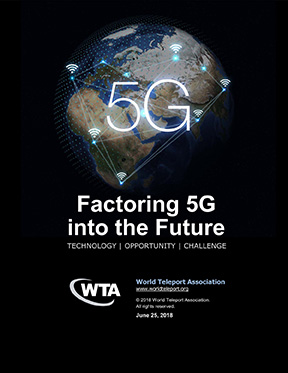How Are You Factoring 5G into Your Future?
by Robert Bell
New York, NY, October 3, 2018-Mobile backhaul and base station networking have long been an important business for satellite and teleport operators. It is humbling, then, to also acknowledge that satellites carried less than 1.4% of global mobile traffic in 2016, according to NSR.
 With 49% of the world’s people still not online, there should be plenty of room for growth. NSR has estimated that satellite-based cellular backhaul in-service units will grow at double-digit rates from about 40,000 in 2016 to more than 120,000 in 2027. The dramatic decline in satellite capacity prices, spacecraft costs and launch costs all portend a future in which satellite may claim a rising share of a growing market.
With 49% of the world’s people still not online, there should be plenty of room for growth. NSR has estimated that satellite-based cellular backhaul in-service units will grow at double-digit rates from about 40,000 in 2016 to more than 120,000 in 2027. The dramatic decline in satellite capacity prices, spacecraft costs and launch costs all portend a future in which satellite may claim a rising share of a growing market.
Massive Growth in Bandwidth Requirements
The roll-out of 5G mobile service has the potential to accelerate that growth. The 5G standard will provide devices on the network with between 1 and 10 Gbps of speed with practically unlimited capacity. Supporting that user capacity will drive a 100x growth in mobile backhaul.
New features already being deployed in 4G LTE encourage mobile operators to concentrate heavy-duty processing in data centers linked to remote base stations, which also creates a market for “fronthaul” that is currently provided by fiber but is likely to need satellite in a 5G future.
Factoring 5G Into the Future
Factoring 5G Into the Future is a new report from the World Teleport Association that looks at the 5G opportunity from the point of view of satellite-based service providers. What specific opportunities are likely to emerge? How are standards evolving in ways that are friendly or unfriendly to satellite? What industry partnerships are working to ensure satellite a place in the 5G specifications?
There are still more questions than answers, but some things seem clear. The first 5G deployments will take place in urban markets where fiber dominates. An industry association contributing to the report noted that “5G will be gradually introduced, but even by 2026, the coverage is expected to be very limited. Cisco is projecting that 5G will account for 1.5% of total mobile data traffic by 2021, and on average each connection will generate 4.7 times more traffic than the average 4G connection.”
Other contributors offered an alternative view. Partly because it represents such a technology leap, 5G deployment may be driven less by geography and population density than by use cases. “It is quite conceivable that there will be ‘islands’ of coverage,” said one respondent. “For example, an industrial park in an otherwise unserved area may have its own 5G network, enabling automation and/or logistics for particular location or company. A small cell could just cover one business.” The executive also noted the opportunity to overlay 5G architecture on existing 4G macro cells. “It could scale faster than we think. Enterprises and verticals are a key target for 5G so hitting those industries – along industrial corridors, ports or industrial parks where there is a need for massive IoT connectivity – will be key to success.”
The Internet of Things is already a market driver for teleport and satellite operators. The 5G specification is expected to become the standard for IoT, so integration with it will be a priority. Communications with objects in motion, currently a satellite specialty, will also be covered by the 5G standards, which will tend to increase demand for service. Most valuable of all may be video. 5G will support a massive increase in video to mobile devices – and the economics suggest that caching video files at the edge could become a major business for teleports.
A Seat at the Table
The 5G standard will not be published in final form until 2020, and there are as yet no 5G consumer handsets on the market. But the satellite industry is pushing as never before to be at the table as specifications are established – because 5G is an architecture that will have a massive impact on how the whole world communicates. The mobile industry wants to finalize the standard as fast as possible and is pushing back on adding a satellite component. The satellite and teleport sectors need to keep up the pressure to ensure their fair share of the massive wave of investment that 5G will create over its decade-long deployment.
----------------------------
Robert Bell is Executive Director of the World Teleport Association, which represents the world’s most innovative teleport operators, carriers and technology providers in 46 nations. He can be reached at rbell@worldteleport.org. Factoring 5G into the Future is available free to members and for sale to non-members.





